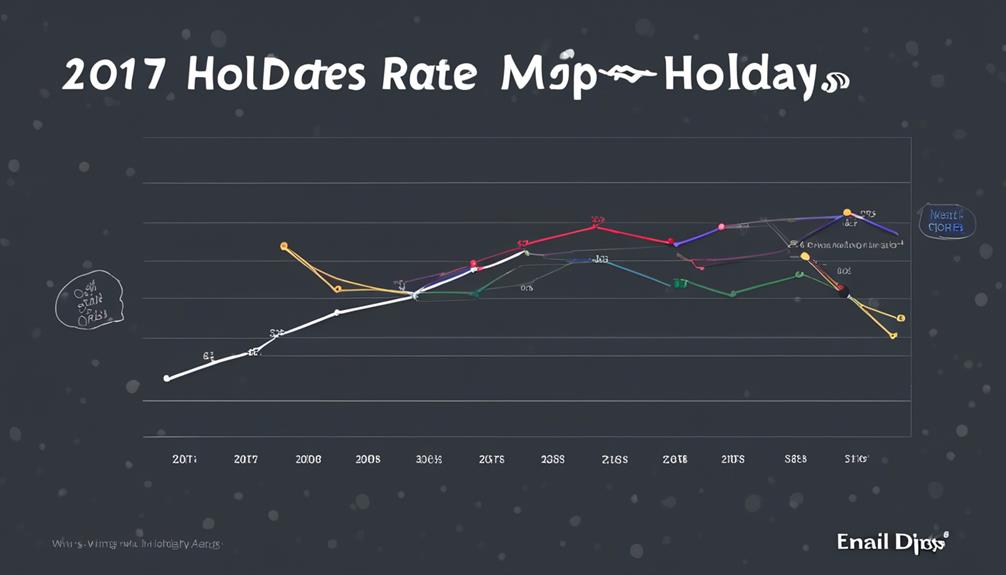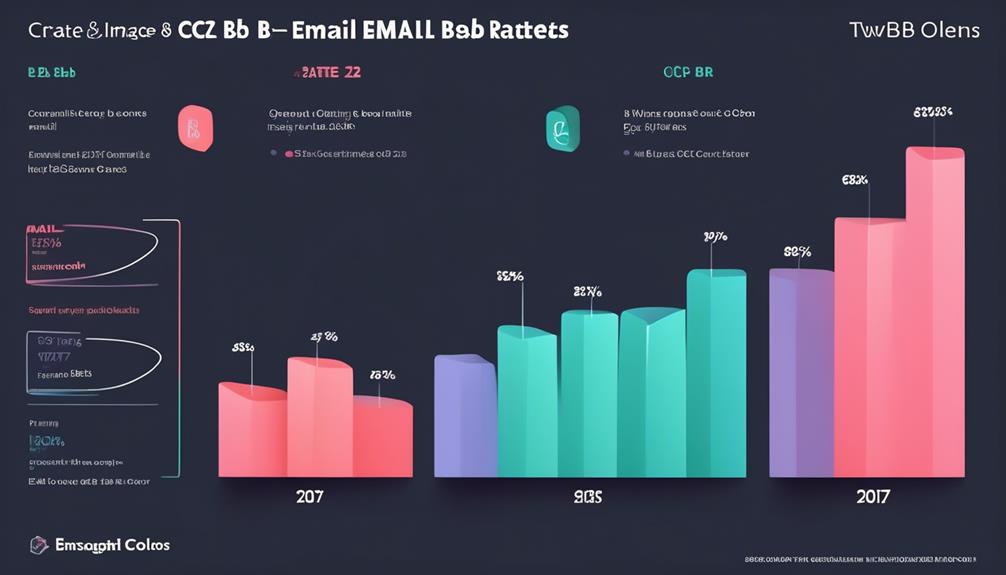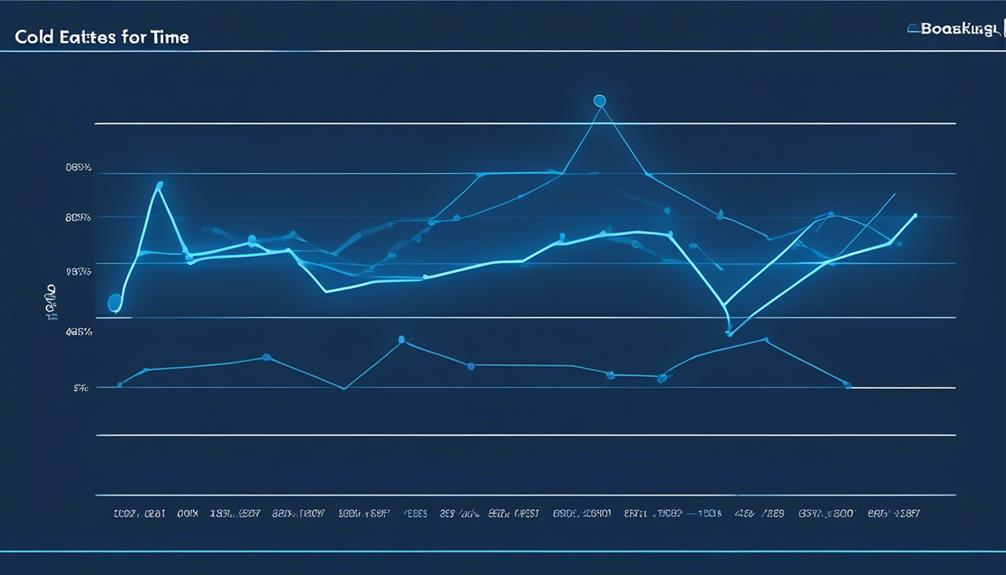In 2017, there was a slight decrease in email open rates across various sectors, indicating a trend worth noting. Although some industries saw a small decline, others stayed relatively stable.
As we explore the factors influencing these fluctuations, it becomes apparent that understanding industry averages and benchmarks is crucial for evaluating the performance of our email campaigns.
What impact did holidays have on open rates? How did automated, manual, and transactional sends compare in terms of open rates? These are just a few of the questions we'll explore as we delve into the intricacies of email open rates in 2017.
Key Takeaways
- Email open rates vary across industries, with the highest rates found in government, leisure, and religion-related emails.
- The holiday season has a significant impact on email open rates, particularly for retail and transportation sectors.
- Automated emails tend to outperform manual ones in terms of unique opens, clicks, and click-to-open rates.
- B2C recipients are more likely to forward emails than B2B recipients, and certain industries have better open rates and engagement.
Industry Averages and Benchmarks
In analyzing industry averages and benchmarks for email open rates, it becomes evident that these metrics provide valuable insights for assessing the performance of email campaigns. The average open rate for emails across all industries in 2017 stood at 21.33%. However, it's essential to note that open rates varied significantly across different sectors, with the highest open rates found in government, leisure, and religion-related emails. These statistics highlight the importance of understanding industry-specific benchmarks when evaluating the success of email marketing efforts.
Moreover, the data revealed that automated emails outperformed manual ones in various metrics, including unique opens, clicks, and click-to-open rates. Surprisingly, less than 5% of all marketing emails sent in 2017 were automated, indicating a significant opportunity for businesses to leverage automation for improved engagement.
Additionally, segmenting email lists emerged as a crucial strategy for enhancing open rates. By targeting specific customer segments, businesses can achieve more effective engagement and better overall open rates. These findings underscore the significance of industry benchmarks and the potential impact of strategic segmentation on email campaign performance.
Impact of Holidays on Open Rates

Analyzing the influence of holidays on email open rates reveals a shift in consumer engagement and industry-specific trends, presenting a dynamic extension of our examination of email campaign performance.
The impact of holidays on email open rates is significant, as evidenced by the increase in online shopping during the holiday season, with online sales expected to surpass $100 billion in 2017. This surge in online shopping directly affects email open rates, as retail companies sent 28% of all emails in November and December, indicating a substantial influence of holidays on email volumes.
Additionally, the transportation sector also contributed to the holiday season's impact on email open rates, sending more emails during this period due to package deliveries.
Moreover, sectors such as Hospitality, Recreation, and Entertainment experienced an uptick in emails, likely related to the holiday season, leading to changes in open rates.
Notably, the Not for Profit sector displayed no significant changes in email volume or engagement rates during the holiday months, highlighting varied impacts of holidays on open rates across different industries.
Automated Vs. Manual Vs. Transactional Sends
Comparing the performance of automated, manual, and transactional email sends reveals distinct patterns in engagement and efficiency. In 2017, automated emails had the highest returns on investment and the lowest spam complaints and unsubscribes. Despite accounting for less than 5% of all marketing emails, they outperformed manual ones in unique opens, clicks, and click-to-open rates. Manual emails, heavily used by the insurance industry, lagged behind in these metrics. The education sector, on the other hand, sent the most automated emails in 2017. Transactional email sends, known for their personalized and timely nature, often boasted the highest open rates and engagement. To provide a clear comparison, we have compiled the following table based on email marketing metrics from 2017:
| Email Type | ROI | Spam Complaints | Unsubscribes |
|---|---|---|---|
| Automated | Highest | Lowest | Lowest |
| Manual | – | – | – |
| Transactional | – | – | – |
Understanding the performance of different email types in 2017 is crucial for mastering email marketing strategies.
B2B Vs. B2C Email Open Rates

When evaluating B2B and B2C email open rates, it becomes apparent that their performance in 2017 mirrored that of the previous year, with slight decreases in unique opens and relatively consistent click-to-open rates.
However, B2B bounce rates were higher than B2C, and B2C recipients were 6 times more likely to forward an email than B2B recipients.
In addition, automated emails outperformed manual ones in unique opens, clicks, and click-to-open rates, with less than 5% of all marketing emails sent in 2017 being automated.
Furthermore, specific industries such as Banking, Legal, Agriculture, Insurance, and Government had the best open rates, while Advertising/Marketing had the highest click-to-open rate.
It's worth noting that most industries saw a slight decrease of about 1-2% in open rates over the first half of 2017, with open rates largely the same compared to the same time period in 2016.
These insights into B2B and B2C email open rates can significantly impact email marketing strategies and the overall conversion rates.
What Changes Have Occurred in Email Open Rates Over the Years?
Over the years, email open rate benchmarks have shown fluctuations. With the rise of mobile devices, open rates have increased as people check emails on the go. However, changes in spam filters and user behavior have also affected open rates, making it important for marketers to stay updated on industry benchmarks.
Strategies to Improve Open Rates
To enhance email open rates, implementing strategic approaches such as A/B testing subject line variations and segmenting email lists based on customer preferences and behaviors is crucial.
A/B testing allows us to experiment with different subject lines, enabling us to identify what resonates best with our subscribers, thus improving open rates.
Segmenting our email lists based on customer preferences, buying habits, and reading behaviors ensures that we can target our customers effectively, leading to higher open rates.
Additionally, following email marketing best practices, such as optimizing subject lines, ensuring mobile optimization, and avoiding spam filters, can increase open rates by up to 20%.
Moreover, it's essential to remove inactive subscribers after 4-6 months, send win-back emails, and eliminate consistently bouncing email addresses to further improve open rates.
Regularly analyzing outliers and campaigns with high and low open rates helps us identify patterns and improve future campaigns, while also understanding past data to optimize open rates.
Frequently Asked Questions
What Is a Typical Open Rate for Emails?
We find that a typical open rate for emails varies across industries. It's an important metric to gauge the effectiveness of your email strategy. High open rates indicate resonance with your audience, while lower rates might call for optimization.
Understanding industry benchmarks can help set realistic goals. As of 2017, the average open rate across all industries was 21.33%, with government-related emails leading at 28.77%, followed by leisure-related at 27.74%, and religion-related at 27.62%.
Is a 40% Email Open Rate Good?
A 40% email open rate is considered excellent. It indicates strong engagement and interest from the audience. This high open rate can lead to increased click-through rates and conversions.
It's crucial to analyze the content and segmentation strategies that contributed to this exceptional performance in order to replicate and build upon this success.
What Is a 50% Open Rate Email?
A 50% open rate email is a strong indicator of audience engagement. It means that half of the recipients have opened the email, showcasing high interest. Achieving this rate is a significant success in email marketing, signifying compelling subject lines and content.
Such a rate suggests that the email content and timing effectively captured the audience's attention, making it a valuable metric for measuring the impact of email campaigns.
How Do I Find Out What Email Rates Are Open?
We find out what email open rates are by analyzing the percentage of recipients who open our emails. This can be tracked through email marketing platforms or software that provides analytics.
A good open rate typically falls between 15-25%, and it's important to segment the audience, test subject lines, and analyze data to adjust our strategies.
Conclusion
So, as we wrap up, it's clear that email open rates in 2017 held steady for most industries, with some slight fluctuations.
The impact of holidays, the type of email sends, and the differences between B2B and B2C open rates all play a role in the overall performance.
By keeping an eye on these factors and implementing effective strategies, businesses can work towards improving their open rates and achieving better results in their email campaigns.
Cheers to that!










